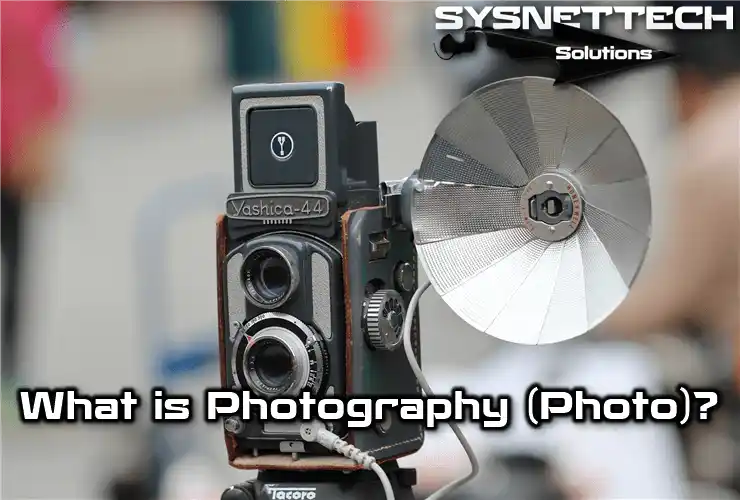Photography (Photo) is the science and art of obtaining permanent images with the effect of light. It is the process of capturing images and fixing them in a light-sensitive material medium.

Photography History and Art
Based on the Camera Obscura principle, an image captured by a small hole is projected onto a surface such that the image is reduced in size, and sharpness increased.
In ancient times, cameras used precision film to store this image, whereas today, CCD and CMOS sensors and digital memories are often used in digital photography.
The term photography consists of the Greek words Light and Graphics and means designing, writing, and processing with light.
The photograph was known as the Daguerreotype before it was used. AlthoughDaguDaguerreotyperreypedevelopment originated from Nicéphore Niepce. The discovery was made public by Louis Daguerre after perfecting the technique.
Photo History
The history of photography begins in 1839 with the worldwide use of the daguerreotype procedure developed and perfected by Daguerre based on Niépce’s previously unpublished experience.
However, the premises begin with the discovery of Camera Obscura and the development and research into the tarnishing of silver salts.
Photography began to be made as an art in France, and it was preferred by the technical innovations of the period during the transition from a pre-industrial society to an industrial society.
Positivist Philosophy also emerges at the same time as photography. This art of philosophy also determines that every element of nature must be tested experimentally.
The bourgeoisie is the dominant social class of the moment, using the portrait as a means of affirmation and affirmation of social ascent.
1800’s
In 1816, Niépce got the first negative image with a dark camera. Later, in 1826, Judean obtained his first Heliography, starting with bitumen or asphalt.
Louis Daguerre was working with Niépce to continue the development. However, as Niépce died in 1833, Daguerre continued alone until a reliable and commercial procedure was achieved.
The Daguerreotype was presented at the French AcadDaguDaguerreotyperretypes and Fine Arts in 1839, and the same year this procedure was published worldwide.
The system was meant to get an image on a polished silver surface but to save money; the plates were typically made of silver copper because it was usually easy to have a silver face.
The image is enhanced by mercury vapors visible on the silver side of the plate, sensitized with iodine vapors. However, it was an expensive procedure and heavy equipment that required several minutes of exposure time at first. Additionally, mercury vapors are truly harmful to health.
In 1840, William Hengenuinelyx Talbot developed a negative-positive system in another procedure called Calotype. This consisted of obtaining a paper negative, which was then positively made by contact with another sheet of paper.
The paper was moistened in acid silver nitrate solution before and after exposure and before fixing. Since a single negative can lead to several positive results, it can be regarded as the invention of photographic copy.
In 1842, the English astronomer and chemist Sir John Frederick William Herschel introduced the work Cyanotype. He was also the first to apply the terms positive and negative to photographic images.
Herschel discovered the solvent power of sodium hyposulfite around insoluble silver salts and set an example of its use as a fixing agent in photography.
He informed Talbot and Daguerre of his discovery in 1839 and that it could be used to fix images permanently, and he made the first glass negative later that year.
To increase the sharpness of the images while avoiding the roughness of the paper, Blanquart Evrard began using Albumen paper in 1850. The fibers of these albumen papers are covered with a layer of egg albumen. This paper was later adapted to silver nitrate, and later, in 1851, the new wet collagen photographic procedure was introduced.
This paper-like collodion liquid is poured into spotless glass plates, and the plates are then sensitized in a silver nitrate tank. Thus, it provides very sharp negative images.
This meant photographers had to carry a portable photo lab with them to prepare the plate before shooting and continue developing it immediately.
Thus, the use of tents and wagons converted into laboratories for travel photographers working abroad has become widespread. From 1855, collodion became widely used, and until 1880 it was the most used material worldwide.
In 1871, a Gelatin-bromide dry plate was developed, which involved the use of a glass plate on which a solution of bromide, water, and gelatin was spread sensitized with silver nitrate, so there was no longer a need to keep the plate wet all the time.
The exposure time is reduced to a quarter of a second, which then makes it possible to approach the photographic shutter concept. However, gelatin-bromide plates were successful only after 1880.
In 1888, George Eastman launched the Kódak camera. Its great commercial success began with the introduction of the film reel, which led to the gradual replacement of glass plates.
1900’s
In 1907, the Lumière factory commercialized color photography, and glass slides known as Autochrome Plates were introduced.
The electronic flash was invented in 1931, and it was used above all when the available light was not enough to shoot with a specific exposure. The flash is a powerful, intense light source that is usually compact and portable.
Polaroid Instant Photography was launched in 1948 as a camera that developed and developed positive images in just 60 seconds.
Finally, in 1990, digitization of the field of photography was developed. Images could be captured by an electronic sensor with multiple photosensitive units and had the backup capability in another electronic element that made up the memory.
Nowadays, we can see how easy it is to take a photo. Thanks to the development of mobile devices, it is possible to shoot at any moment at any time.
In short, it is now possible to see cameras integrated into a mobile phone. This is a great technological marvel and is being developed excellent more.



